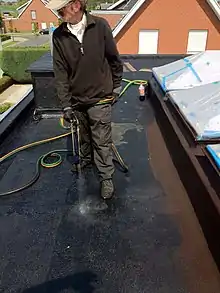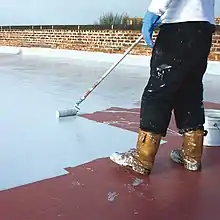Liquid roofing
Liquid roofing is the process of waterproofing a roof by the application of a hydrophobic liquid roof coating. It can be applied to most roof styles, including flat, pitched, and domed roofs.

History
The concept of liquid roofing has a long history dating back to the early 1800s, where natural bitumen was combined with various materials for waterproofing. Over the years, liquid roof coatings evolved, with early coatings based on liquefied rubber in the 20th century. Advancements in the 1960s and 1970s introduced acrylics, acrylic emulsions, styrene-butadiene, and unsaturated polyesters, leading to improved quality and durability. In 1975, the first water-based elastomeric roof coatings were introduced, and in the late 1980s, single-component moisture-cured polyurethane coatings were developed, forming the basis of modern cold liquid roof coating technologies.[1]
Concept

Liquid roofing involves the application of a monolithic, fully-bonded, liquid coating to a roof. The coating cures to form a rubber-like elastomeric waterproof membrane capable of stretching and returning to its original shape. Such coating systems are usually reinforced with secondary materials, such as glass-reinforced plastic, to provide additional tensile strength. The coatings can be applied over most traditional roofing materials, including felt, asphalt, bitumen, and concrete.[2] Liquid spray-applied roofing membranes have been one of the fastest growing roofing systems in North America and Europe.[3]
Benefits
Cost-effectiveness
The process of liquid roofing provides a cost-effective method of making a new or existing roof waterproof because it is potentially less expensive than overall roof replacement for refurbishment.[4]
Safety
Unlike the installation of felt, asphalt and bitumen membranes, liquid roofing does not involve hot equipment. The coating material used in liquid roofing process is applied at ambient temperatures, thus mitigating fire risks posed by hot roofing equipment.[3]
Encapsulation
When applied, liquid roofing creates a coat that protects the surface underneath from weathering. This is especially desirable when working with asbestos roofs, as attempted removal of asbestos roofing can damage it and release material that can induce asbestosis. Using a liquid coating system seals the asbestos and makes disturbance of the material more difficult.
Easy application
Application is simplified by fast curing and resistance to extreme temperatures (between -40 °C and +80 °C). Minimal equipment is needed in installation.
References
- "History of Liquid Waterproofing". Liquid Roofing and Waterproofing Association. Archived from the original on 1 October 2011. Retrieved 12 September 2011.
- "Liquid-Applied Monolithic Membrane Systems". Roof Coatings Manufacturers Association. Retrieved 12 September 2011.
- "Integrity Testing for Roofing and Waterproofing Membranes | WBDG - Whole Building Design Guide".
- "The benefits of liquid roofing". Why use liquid waterproofing. Liquid Roofing & Waterproofing Association. Archived from the original on 1 October 2011. Retrieved 12 September 2011.